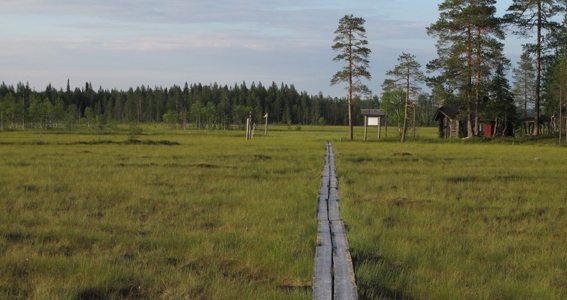Jouni Laaksonen 2.7.2018
This is the third post in a row when I talk about walking longish distances. I promise this is the last one on this subject for a long while. But once more, this time considerably shorter day marches, and with a July angle.
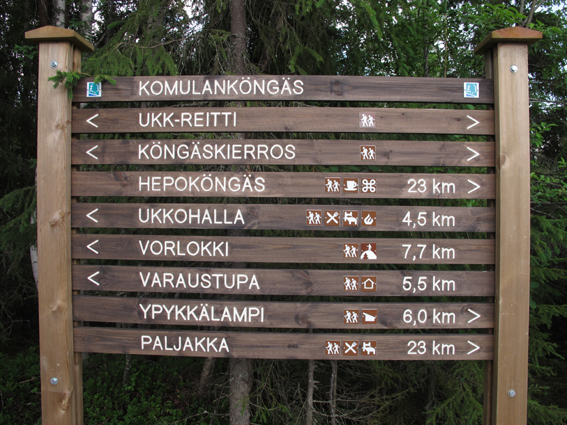
Which one is better?
- Walk fast and cover tens of kilometers per day? Like 30–40 km per day.
- Walk slowly, or at least not long day marches? Like 12 km per day.
Option 2 has the advantage of being luxuriously relaxed, in no hurry whatsoever, and able to add extra loops into the planned day march, if something interesting comes along. And if you walk slowly and stop often, you see more about the wildlife around you.
On the other hand, option 1 allows you to see a large piece of a wilderness. If you have one week, and reserve one day as a rest day, you walk 72 km in option 2. In option 1 you cover over 200 km. If you have a really long trail to walk through, like thousands of kilometers, you probably vote for option 1. You see places in the heart of the large wilderness area – views you cannot reach with option 2 approach in a week.
I don’t think either of these is the better overall. I use both methods, and mix them, depending on my entourage, schedule and destination. As in all hiking, I recommend you don’t fixate on one method, or piece of equipment, but think widely, test new methods and find out what suits you.
Aspects of July
In July 2014 I was busy, but got a two-day opening. I had wanted to walk Köngäskierros trail in my home province Kainuu for some time, and now I decided to do that. Köngäs kierros is about 60 km long, so two days meant longish day marches.
I packed a lightweight 35 liters backpack. It was hot, about +25°C, so a lot of water was needed. In Lapland I drink from almost any stream, river or wilderness lake, but south of Lapland is more inhabited, and surely clean sources of water are not so sure to come by. I knew one sure water source at about halfway, and naturally filled my bottles there.
Keeping food from getting bad is one of the problems when temperatures are high. Dried food is a very good solution to this. However, I like to have something tasty on my bread, like butter and cheese. I had freezed two half liter bottles of water and packed them together with butter and cheese to a plastic bag. A thermo bag would have been even better, but I didn’t happen to have one.
This worked just fine. In the evening of day one the last chips of ice were just melting to water in the bottles, so they kept my butter and cheese well cooled through the hot day. And after that work they served me as one liter of drinking water.
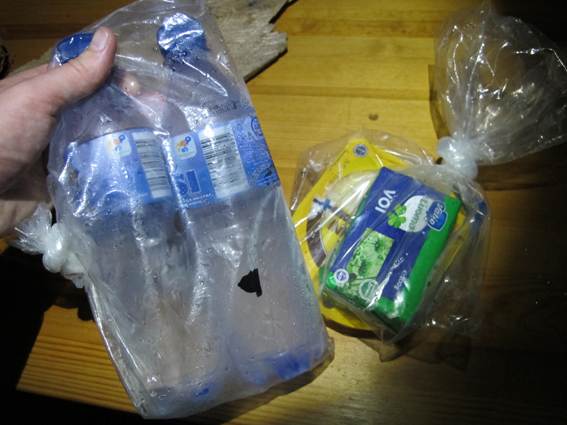
It’s midnight on day one. After eleven hours of hiking, plus two hours of driving before that, the freezed water bottles have only just now melted thoroughly. The water, and my butter and cheese, are very cold.
Another important thing about July is naturally the mosquitoes. You can do very nice day hiking even in July without mosquitoes bothering you much, if you choose to walk in dry pine forests and ridges, or paddle, or bicycle. Treeless fells offer often windy conditions, and windy means no mosquitoes.
However, when you head to a trail like Köngäskierros, with versatile terrain, including spruce forests and bogs, you will encounter zillions of mosquitoes.
I started at Komulmanköngäs waterfall and got to walk through dry pine forests for the first kilometers. As I kept a brisk pace, mosquitoes did not bother me when I was on the move. But when I hit moister spruce forests, even fast pace did not help. I had to change t-shirt to long-sleeved thin jacket, and add a mosquito headnet. I thought that would be enough as I planned to continue walking fast. It wasn’t, there were annoyingly many mosquitoes all the time in my bare hands. I put thin gloves on, and finally got my peace.
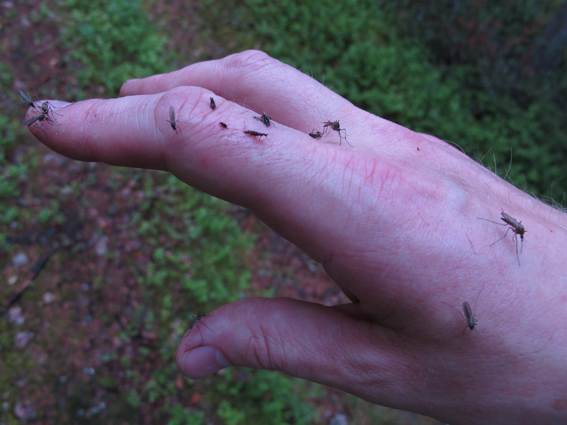
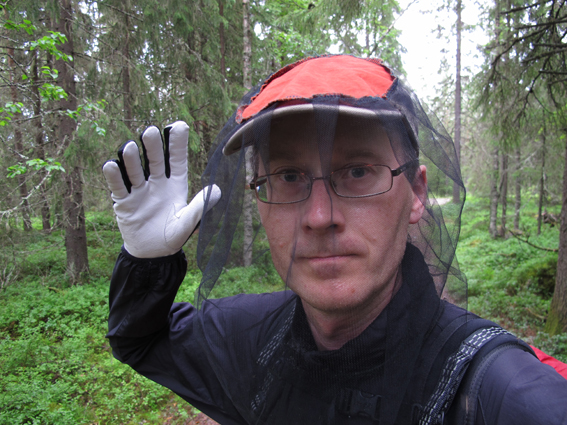
My way of coping with mosquitoes: thin, but bugproof clothing. Of course you can use insect repellents, too. I don’t like using them, but it’s just a quirk of mine.
A large bunch of mosquitoes, horse-flies and other bloodsuckers is mentally very stressing – as long as you are exposed to them. As soon as you know the whining and buzzing around you cannot reach your skin any more, you get relaxed. The same in the evening: if there’s a chance a whining mosquito can get to suck your blood, sleeping is difficult. But when you are inside your insect-proof tent, it does not matter if the buzz loudly between the inner and outer tent cloth.
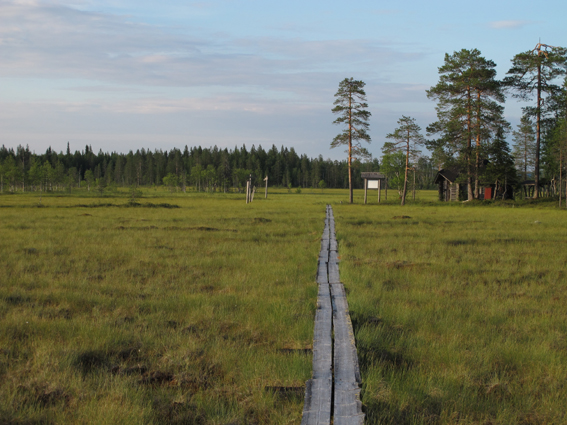
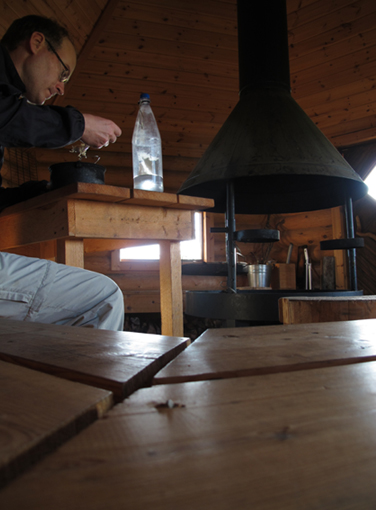
Joutensuo Lappish pole tent was a good place to eat my late lunch. This kota is situated in a beautiful place in the middle of an un-ditched mire, and it offered me a mosquito-free room to prepare and eat my food.
July does not sound like a good month for hiking, eh? Well, I personally do no not think it is the best one. Beginning of June, August and September are better in my opinion. Hot weather makes me lethargic, and mosquitoes are sometimes a nuisance.
On the other hand wild flowers, and butterflies and dragonflies, and fishing, and swimming, are at their best in July. To see fell flowers like Glacier Buttercup, Lady’s Slipper, Yellow Mountain Saxifrage, Mountain Avens and so on you need to choose July. Also the fauna is in full swing in July. Along this trek I saw a couple of litters of black grouse, for example.
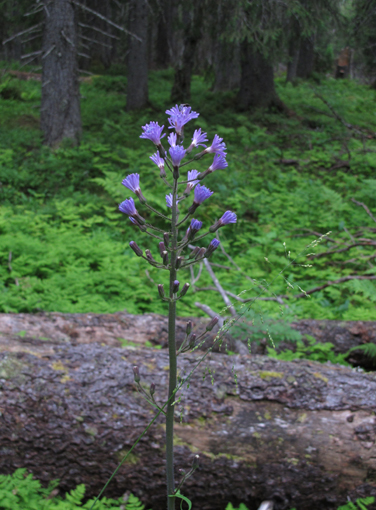
Alpine Sowthistle blooms in July in Paljakka.
Köngäskierros Trail
I walked 30 km on the first day and 30 km the second one. Walking 30 km a day is rather lot, considering I had some driving to and from the trail, too. However, I did not have more time this time. Walking a longer than usual day march now and then also gives the feeling that “I can still do this! I’m not completely in bad shape.” 🙂
So, I loved Komulanköngäs waterfall, Kokkoharju old pine forest, Joutensuo mire, untouched spruce forests of Mustakumpu and Paljakka Strict Nature Reserve (I made a detour there), and ridges like Koppelosärkkä and Iso-Ypykkä. Also all of the lean-tos, Lappish pole tents and day trip huts along the trail, nine of them, are situated in lovely places.
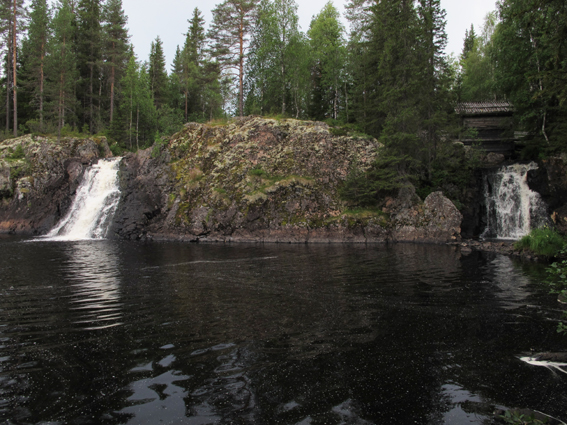
Komulanköngäs is not the highest of waterfalls, but it is rather interesting. The waterfall on laft is the natural one. The waterfall on right is man-made. Our ancestors wanted to build a water mill on this river. I imagine they built one on the natural channel first, but probably the spring flood and ice teared that mill apart soon. So they extracted a canal through the rock to produce another channel for the water. During 19th century, and even on to 20th century water mills were common and important in our region. This Komulanköngäs mill you can see above the right-hand waterfall was the most efficient of all the water mills in Kainuu province.
I would hope more people hiked Köngäskierros. More Finnish people, that is. The southern part of the trail has so little usage that the path is starting to disappear at places, so I don’t recommend this trail for those of you planning to come from abroad to Finland. For example our 40 national parks, and dozens of other hiking destinations are better starting places for you.
Still, it’s sad how forgotten this trail has become. There is potential to it. I liked my two days out there.
* * *
Next week it’s time for an announcement…

